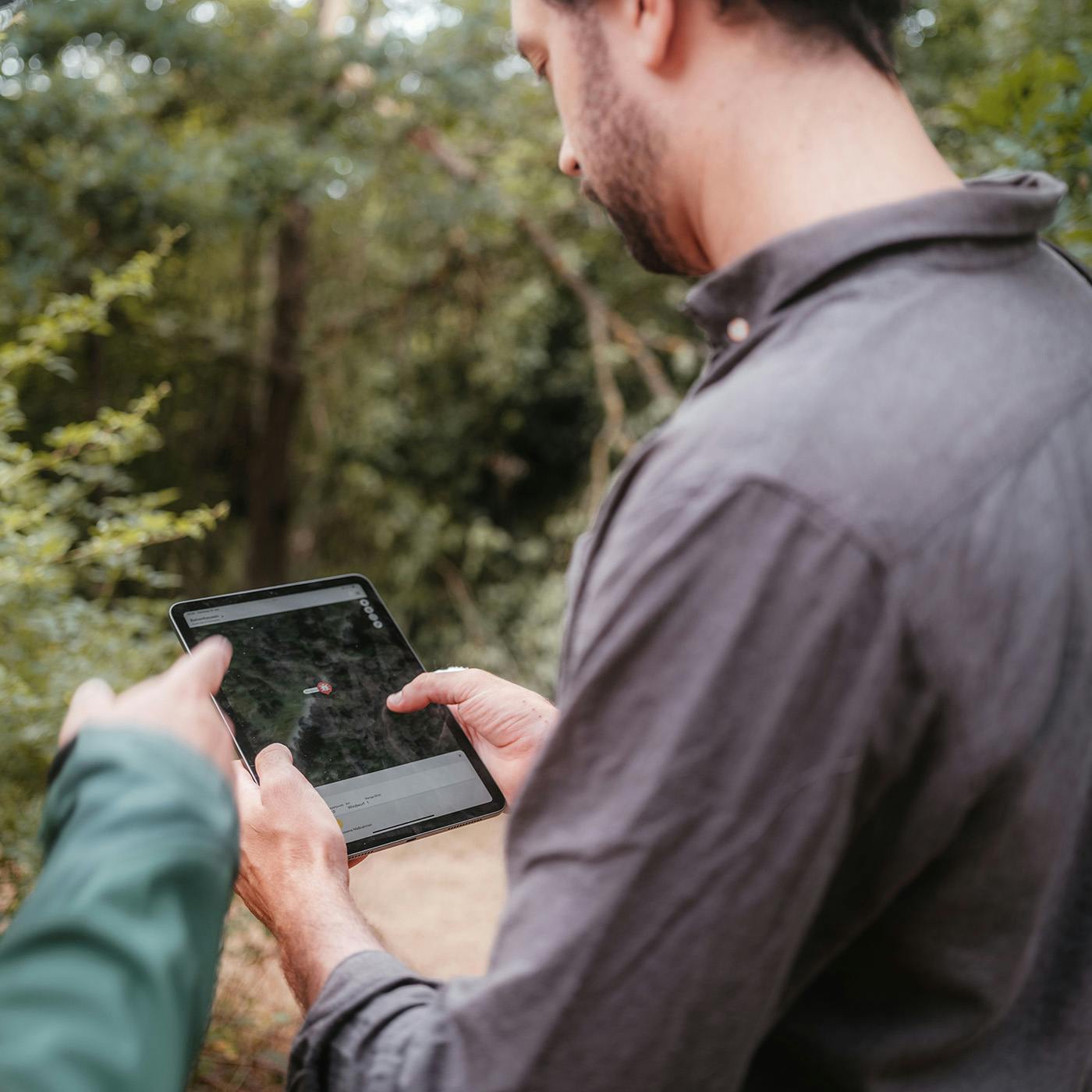Visit us from May 15 to 17 at the GREENTECH FESTIVAL at Messe Berlin. We look forward to seeing you! 👉🏽 Book an appointment at our booth now.

Confidently Investing in Nature:
The Role of Robust MRV Systems
Many buyers of carbon credits are currently feeling uncertain. There are recurring critical articles about projects that allegedly do not remove the promised amount of CO2 from the atmosphere. Such reports are crucial for highlighting issues and sensitizing companies looking to invest in climate protection projects to scrutinize carefully.
At the same time, there seems to be insufficient information on how buyers can distinguish between good and bad projects to make meaningful investments. After all, doing nothing is not an option! International climate goals are unattainable without measures to remove CO2 from the atmosphere. "To limit global warming to 2°C or less, we must accelerate the pace of emission reduction and also remove more carbon by restoring and enhancing ecosystems," says Dr. Steve Smith, Executive Director at Oxford Net Zero, an interdisciplinary climate research initiative at the University of Oxford.
So, how can companies purchasing carbon credits and looking to invest in climate protection projects be sure that the promised amount of CO2 is indeed being reduced or removed?
Here, a robust MRV system comes into play, ensuring greater confidence among buyers, which we introduce in this article.
Contents:
- What is MRV?
- Measurement
- Reporting
- Verification
- Advantage through technology
- Checklist for buyers of CO2 certificates
- Without MRV, it's not feasible
What is MRV?
MRV stands for Measurement, Reporting, Verification, which refers to the process of measuring, reporting, and verifying activities that serve to remove or reduce CO2 from the atmosphere.
A robust MRV system is crucial for high-quality carbon credits, as it makes the process of assessing and certifying CO2 transparent, precise, and trustworthy. It provides a reliable framework for verifying the effectiveness of carbon credits. Buyers are thus assured that each ton of CO2 purchased through credits has indeed been removed from the atmosphere or its emission prevented. This ensures that the projects underlying the certificates result in real, measurable climate protection measures. A certificate corresponds to one ton of CO2 equivalent.
The MRV system represents a multi-stage process consisting of measuring, reporting, and verifying data.
Measurement
Reliably measuring the CO2 reduced or removed by climate protection projects has always been a significant challenge. Initially, a so-called baseline scenario must be established for comparison against future changes due to the project. The calculation of the baseline depends on the type of project.
OCELL captures the current state of the forest using a digital forest inventory supported by the latest technology. This digital method offers a precise overview of the forest, far beyond what a traditional manual inventory based on samples can achieve. With this technology, we gain a detailed insight into what stands in the forest - the exact number of trees, their species, and age class. Based on this data, the current CO2 storage of the forest can be calculated very accurately.
Learn here how forest owners are using OCELL's Digital Forest Inventory.
After measuring the baseline before the project starts, regular monitoring must take place in the future. These show the changes that have occurred since the start of the project, such as in forest inventory. Based on this data, the actual CO2 storage or CO2 savings achieved since the project began can be calculated. It's important for these projects to result in positive impacts that would not have occurred without the project. For Improved Forest Management projects, for example, this means that trees would have been harvested for timber production without the climate protection project and would not have sequestered additional CO2.
Measurements have become simpler in recent times thanks to new technologies, which allow for more regular and precise data collection and easier surveying of large areas. Additionally, depending on the type of project, it can be beneficial to involve local people who can record changes and carry out regular spot checks.

A forest worker uses the Dynamic Forest software to document all forest activities. (photograph: OCELL)
Therefore, OCELL works closely with forestry operations whose staff record their daily activities—such as assessing tree damage or new plantings—using software.
Subsequently, the collected results are presented to an accredited third party for review and confirmation.
Reporting
A report is generated from the gathered data and submitted to independent third parties for review and certification. The report includes not only the amount of CO2 saved or stored but also detailed data used to calculate the CO2 amount.
For OCELL's climate protection projects, buyers of CO2 credits also gain access to detailed project data to understand the impact of their investment.
Verification
Third-party verification of data is a crucial step to ensure the integrity and credibility of climate protection projects. This process is conducted by external auditors or certification bodies accredited according to the standards of the respective climate protection initiative. OCELL works with the ISO standard, TÜV Nord as certification body, and Waldklimastandard as carbon standard. Other well-known standards include the Gold Standard and Verra. The goal is to confirm the accuracy and completeness of the reported emission data. Auditors often have to sift through very comprehensive datasets. Well-documented results that clearly demonstrate accuracy, transparency, and compliance with the standard significantly facilitate this process.
Special attention is given to the aspects of additionality, permanence, and leakage. These factors are crucial to ensure that claims about removing or reducing CO2 are scientifically sound and robust. Following a successful review, CO2 certificates are certified, with each certificate being assigned a unique number. This number is used to track and transfer the certificates, including recording their use and retirement.
The verification process is detailed and strict. Project developers must provide all data to demonstrate how their projects reduce and remove emissions. They must also undergo random checks to uncover errors and inconsistencies, which are then corrected. As a result, issuing CO2 certificates for a climate protection project can take a considerable amount of time. However, this is important as verification helps limit manipulations and dubious practices, fostering integrity and trust.
Advantage through technology
Technological progress is a real game-changer, including for CO2 certificates. While traditional, mostly manual methods of measuring, reporting, and verifying projects are very time-consuming and often prone to errors, digital technologies offer an efficient alternative. Automated data collection and processing, along with improved quality control, allow more climate protection projects and thus CO2 certificates to be set up in a short time without compromising quality.
For this reason, OCELL employs innovative approaches to collect and provide high-quality impact data. OCELL relies on remote sensing, Lidar, aerial photography, and operational data from the Forest Dynamic software, where project partners record all activities in the forest. Using all these data, a digital twin of the forest is created with the help of artificial intelligence to accurately measure the CO2 storage in forests. This technology also plays a key role in monitoring. With this approach, we ensure that we deliver precise and reliable data essential for the effective implementation and evaluation of climate protection projects.
Overall, these developments show how CO2 credits can increase transparency and reliability through the use of technology.
Checklist for buyers of carbon credits
In recent years, the ability to reliably measure projects and their impact, thus ensuring their quality, has continuously improved. But how can you as a buyer be sure that the projects have a robust MRV system?
✅ Insist on transparent data: You should receive regular reports showing the current status of your project. Reliable project developers have up-to-date data and are not hesitant to provide it to you, preferably unsolicited.
✅ Proximity to the project: How close is the developer to the project, and do they work closely with local experts, such as forest owners? Are these local projects? Do you, as a buyer, have the opportunity to visit the project and verify its current status?
✅ Use of technology: Ask for detailed explanations on how data is collected, calculated, and monitored. Projects based on innovative technology can be advantageous because they can also process large volumes of data accurately. However, this does not mean that manually set up projects are automatically inferior. The difference lies in the quantity. Those who manually set up only a few projects can also do so with high quality.
✅ Consider the price: Buying as many CO2 certificates as possible for little money sounds like a good deal at first. However, the quality of the projects and thus the real impact created can suffer. Therefore, as often is the case with CO2 credits: less is more. If you have a specific budget, it's better to buy fewer certificates at a higher price. Good MRV costs money: development costs, continuous monitoring, and third-party verification. All these increase the security of the promised CO2 savings significantly. A higher price can thus also mean a lower risk.
Additional crucial quality criteria for climate protection projects include additionality, permanence, and leakage. Let your project contact explain these to you in detail.
MRV is indispensable
In conclusion, the MRV process plays a key role in the world of CO2 certificates and climate protection. The market needs more reliability, transparency, and effectiveness to develop carbon credits with real impact. This also promotes credibility and thus trust among buyers and all other participants in the carbon market. And only when companies can be sure that their financial aid contributes to reducing or removing CO2 will they make corresponding investments. Investments that are urgently needed to achieve the 1.5-degree target.